Investigation of the Wear Behavior of Dual-Matrix Aluminum–(Aluminum–Carbon Nanotube) Composites
Abstract
:1. Introduction
2. Materials and Methods
3. Results and Discussion
3.1. Hardness Investigation
3.2. Wear Investigation
4. Conclusions
Author Contributions
Funding
Institutional Review Board Statement
Informed Consent Statement
Acknowledgments
Conflicts of Interest
References
- Nieto, A.; Agarwal, A.; Lahiri, D.; Bisht, A.; Bakshi, S.R. Carbon Nanotubes: Reinforced Metal Matrix Composites; CRC Press: Boca Raton, FL, USA, 2021. [Google Scholar]
- Yue, Y.; Zhou, L.; Li, M.; Xu, F.; Cai, X. Research Progress on Microstructure Design of CNTs Reinforced Al Matrix Composites. Integr. Ferroelectr. 2023, 234, 22–32. [Google Scholar] [CrossRef]
- Esawi, A.; Morsi, K. Dispersion of carbon nanotubes (CNTs) in aluminum powder. Compos. Part A Appl. Sci. Manuf. 2007, 38, 646–650. [Google Scholar] [CrossRef]
- Raviathul Basariya, M.; Srivastava, V.C.; Mukhopadhyay, N.K. Microstructural characteristics and mechanical properties of carbon nanotube reinforced aluminum alloy composites produced by ball milling. Mater. Des. 2014, 64, 542–549. [Google Scholar] [CrossRef]
- Hao, X.-N.; Zhang, H.-P.; Zheng, R.-X.; Zhang, Y.-T.; Ameyama, K.; Ma, C.-L. Effect of mechanical alloying time and rotation speed on evolution of CNTs/Al-2024 composite powders. Trans. Nonferrous Met. Soc. China 2014, 24, 2380–2386. [Google Scholar] [CrossRef]
- Omidi, M.; Khodabandeh, A.; Nategh, S.; Khakbiz, M. Microstructural and tribological properties of nanostructured Al6061-CNT produced by mechanical milling and extrusion. Adv. Powder Technol. 2018, 29, 543–554. [Google Scholar] [CrossRef]
- George, R.; Kashyap, K.T.; Rahul, R.; Yamdagni, S. Strengthening in carbon nanotube/aluminium (CNT/Al) composites. Scr. Mater. 2005, 53, 1159–1163. [Google Scholar] [CrossRef]
- Jafari, M.; Abbasi, M.H.; Enayati, M.H.; Karimzadeh, F. Mechanical properties of nanostructured Al2024–MWCNT composite prepared by optimized mechanical milling and hot pressing methods. Adv. Powder Technol. 2012, 23, 205–210. [Google Scholar] [CrossRef]
- Pérez-Bustamante, R.; Bueno-Escobedo, J.L.; Jiménez-Lobato, J.; Estrada-Guel, I.; Miki-Yoshida, M.; Licea-Jiménez, L.; Martínez-Sánchez, R. Wear behavior in Al2024–CNTs composites synthesized by mechanical alloying. Wear 2012, 292–293, 169–175. [Google Scholar] [CrossRef]
- Al-Qutub, A.M.; Khalil, A.; Saheb, N.; Hakeem, A.S. Wear and friction behavior of Al6061 alloy reinforced with carbon nanotubes. Wear 2013, 297, 752–761. [Google Scholar] [CrossRef]
- Bastwros, M.M.H.; Esawi, A.M.K.; Wifi, A. Friction and wear behavior of Al–CNT composites. Wear 2013, 307, 164–173. [Google Scholar] [CrossRef]
- Abdullahi, U.; Maleque, M.A.; Nirmal, U. Wear Mechanisms Map of CNT-Al Nano-composite. Procedia Eng. 2013, 68, 736–742. [Google Scholar] [CrossRef] [Green Version]
- Piasecki, A.; Paczos, P.; Tuliński, M.; Kotkowiak, M.; Popławski, M.; Jakubowicz, M.; Wieczorowski, M. Microstructure, mechanical properties and tribological behavior of Cu-nano TiO2-MWCNTs composite sintered materials. Wear 2023, 522, 204834. [Google Scholar] [CrossRef]
- Aydin, F. The investigation of the effect of particle size on wear performance of AA7075/Al2O3 composites using statistical analysis and different machine learning methods. Adv. Powder Technol. 2021, 32, 445–463. [Google Scholar] [CrossRef]
- Abbasipour, B.; Niroumand, B.; Vaghefi, S.M.M.; Abedi, M. Tribological behavior of A356−CNT nanocomposites fabricated by various casting techniques. Trans. Nonferrous Met. Soc. China 2019, 29, 1993–2004. [Google Scholar] [CrossRef]
- Manjunath Naik, H.R.; Manjunath, L.H.; Malik, V.; Manjunath Patel, G.C.; MeSaxena, K.K.; Lakshmikanthan, A. Effect of microstructure, mechanical and wear on Al-CNTs/graphene hybrid MMC’S. Adv. Mater. Process. Technol. 2022, 8 (Suppl. S2), 366–379. [Google Scholar]
- Srinivas, V.; Jayaraj, A.; Venkataramana, V.S.N.; Avinash, T.; Dhanyakanth, P. Effect of ultrasonic stir casting technique on mechanical and tribological properties of aluminium–multi-walled carbon nanotube nanocomposites. J. Bio-Tribo-Corros. 2020, 6, 3. [Google Scholar] [CrossRef]
- Sahoo, B.; Narsimhachary, D.; Paul, J. Surface mechanical and self-lubricating properties of MWCNT impregnated aluminium surfaces. Surf. Eng. 2019, 35, 970–981. [Google Scholar] [CrossRef]
- Kumar, L.; Alam, S.N.; Sahoo, S.K. Influence of nanostructured Al on the mechanical properties and sliding wear behavior of Al-MWCNT composites. Mater. Sci. Eng. B 2021, 269, 115162. [Google Scholar] [CrossRef]
- Kumar, R.; Bhowmick, H.; Gupta, D.; Bansal, S. Development and characterization of multiwalled carbon nanotube-reinforced microwave sintered hybrid aluminum metal matrix composites: An experimental investigation on mechanical and tribological performances. Proc. Inst. Mech. Eng. Part L J. Mater. Des. Appl. 2021, 23, 2310–2323. [Google Scholar] [CrossRef]
- Bradbury, C.R.; Gomon, J.-K.; Kollo, L.; Kwon, H.; Leparoux, M. Hardness of Multi Wall Carbon Nanotubes reinforced aluminium matrix composites. J. Alloy. Compd. 2014, 585, 362–367. [Google Scholar] [CrossRef]
- Morsi, K.; Esawi, A.M.K.; Lanka, S.; Sayed, A.; Taher, M. Spark plasma extrusion (SPE) of ball-milled aluminum and carbon nanotube reinforced aluminum composite powders. Compos. Part A Appl. Sci. Manuf. 2010, 41, 322–326. [Google Scholar] [CrossRef]
- Runkle, J.C. Method for Making Tool Steel with High Thermal Fatigue Resistance. U.S. Patent 5,290,507, 1 March 1994. [Google Scholar]
- Odeshi, A.G.; Mucha, H.; Wielage, B. Manufacture and characterisation of a low cost carbon fibre reinforced C/SiC dual matrix composite. Carbon 2006, 44, 1994–2001. [Google Scholar] [CrossRef]
- Morsi, K.; Patel, V.V.; Naraghi, S.; Garay, J.E. Processing of titanium–titanium boride dual matrix composites. J. Mater. Process. Technol. 2008, 196, 236–242. [Google Scholar] [CrossRef]
- Deng, X.; Patterson, B.; Chawla, K.; Koopman, M.; Mackin, C.; Fang, Z.; Lockwood, G.; Griffo, A. Microstructure/hardness relationship in a dual composite. J. Mater. Sci. Lett. 2002, 21, 707–709. [Google Scholar] [CrossRef]
- Patel, V.V.; El-Desouky, A.; Garay, J.E.; Morsi, K. Pressure-less and current-activated pressure-assisted sintering of titanium dual matrix composites: Effect of reinforcement particle size. Mater. Sci. Eng. A 2009, 507, 161–166. [Google Scholar] [CrossRef]
- Fang, Z.; Lockwood, G.; Griffo, A. A Dual composite of WC-Co. Metall. Mater. Trans. A 1999, 30, 3231–3238. [Google Scholar] [CrossRef]
- Lakra, S.; Bandyopadhyay, T.K.; Das, S.; Das, K. Synthesis and characterization of in-situ (AleAl3TieAl2O3)/Al dual matrix composite. J. Alloy. Compd. 2020, 842, 155745. [Google Scholar] [CrossRef]
- Eltaher, M.A.; Wagih, A.; Melaibari, A.; Fathy, A.; Lubineau, G. Effect of Al2O3 particles on mechanical and tribological properties of Al–Mg dual-matrix nanocomposites. Ceram. Int. 2020, 46, 5779–5787. [Google Scholar] [CrossRef]
- Esawi, A.; Morsi, K.; Salama, I.; Saleeb, H. Processing Challenges of Dual-Matrix Carbon Nanotube Aluminum Composites. In Proceedings of the "Randall M. German Honorary Symposium on Sintering and Powder-Based Materials“, TMS Spring Conference, Orlando, FL, USA, 11–15 March 2012; Volume 1, pp. 545–552. [Google Scholar]
- Salama, E.I.; Abbas, A.; Esawi, A.M.K. Preparation and properties of dual-matrix carbon nanotube-reinforced aluminum composites. Compos. Part A Appl. Sci. Manuf. 2017, 99, 84–93. [Google Scholar] [CrossRef]
- Bastwros, M.M.H.; Esawi, A.M.K.; Wifi, A. Tribological behavior of dual matrix Al-CNT Composites, In Proceedings of the JSME/ASME 2014 International Conference on Materials and Processing (ICMP2014), Detroit, Michigan, USA, 9–13 June 2014.
- Montgomery, D.C. Design and Analysis of Experiments; John Wiley & Sons: Hoboken, NJ, USA, 2008. [Google Scholar]
- Maghsoodloo, S.; Ozdemir, G.; Jordan, V.; Huang, C.-H. Strengths and limitations of taguchi’s contributions to quality, manufacturing, and process engineering. J. Manuf. Syst. 2004, 23, 73–126. [Google Scholar] [CrossRef]
- Kumar, R.; Dhiman, S. A study of sliding wear behaviors of Al-7075 alloy and Al-7075 hybrid composite by response surface methodology analysis. Mater. Des. 2013, 50, 351–359. [Google Scholar] [CrossRef]
- El-Tayeb, N.; Yap, T.; Brevern, P. Wear characteristics of titanium alloy Ti54 for cryogenic sliding applications. Tribol. Int. 2010, 43, 2345–2354. [Google Scholar] [CrossRef]
- Gajjal, S.Y.; Unkule, A.J.; Gajjal, P.S. Taguchi Technique for Dry Sliding Wear Behavior of PEEK Composite Materials. Mater. Today Proc. 2018, 5, 950–957. [Google Scholar] [CrossRef]
- Ghalme, S.; Mankar, A.; Bhalerao, Y. Integrated Taguchi-simulated annealing (SA) approach for analyzing wear behaviour of silicon nitride. J. Appl. Res. Technol. 2017, 15, 624–632. [Google Scholar] [CrossRef] [Green Version]
- Taguchi, G.; Konishi, S. Orthogonal Arrays and Linear Graphs: Tools for Quality Engineering; American Supplier Institute: Cairo, Egypt, 1987. [Google Scholar]
- Standard, A. G99, Standard Test Method for Wear Testing with a Pin-on-Disk Apparatus; ASTM International: West Conshohocken, PA, USA, 2006. [Google Scholar]
- Baskaran, S.; Anandakrishnan, V.; Duraiselvam, M. Investigations on dry sliding wear behavior of in situ casted AA7075–TiC metal matrix composites by using Taguchi technique. Mater. Des. 2014, 60, 184–192. [Google Scholar] [CrossRef]
- Singh, S.K.; Sudeepan, J.; Kumar, K.; Barman, T.K.; Sahoo, P. Study of Friction and Wear of ABS/Zno Polymer Composite Using Taguchi Technique. Procedia Mater. Sci. 2014, 6, 391–400. [Google Scholar]
- Joshi, A.Y.; Patel, V.N.; Banker, V.J.; Mistry, J.M.; Thakor, M.R.; Upadhyay, B.H. Wear Behavior in Dry Sliding of Inconel 600 Alloy Using Taguchi Method and Regression Analysis. Procedia Technol. 2016, 23, 383–390. [Google Scholar]
- Singh, S.K.; Zakaulla, M.; Khan, A.R.A.; Mukunda, P.G. Evaluation of the Taguchi Method for Wear Behavior of Al6061/Cu-SiC/Cu-Gr Hybrid Composite. Mater. Today Proc. 2015, 2, 2951–2958. [Google Scholar]
- Murugan, K.; Ragupathy, A.; Balasubramanian, V.; Sridhar, K. Optimizing HVOF spray process parameters to attain minimum porosity and maximum hardness in WC–10Co–4Cr coatings. Surf. Coat. Technol. 2014, 247, 90–102. [Google Scholar] [CrossRef]
- Kiran, T.S.; Kumar, M.P.; Basavarajappa, S.; Viswanatha, B.M. Dry sliding wear behavior of heat treated hybrid metal matrix composite using Taguchi techniques. Mater. Des. 2014, 63, 294–304. [Google Scholar] [CrossRef]
- Pan, S.; Saso, T.; Yu, N.; Sokoluk, M.; Yao, G.; Umehara, N.; Li, X. New study on tribological performance of AA7075-TiB2 nanocomposites. Tribol. Int. 2020, 152, 106565. [Google Scholar] [CrossRef]
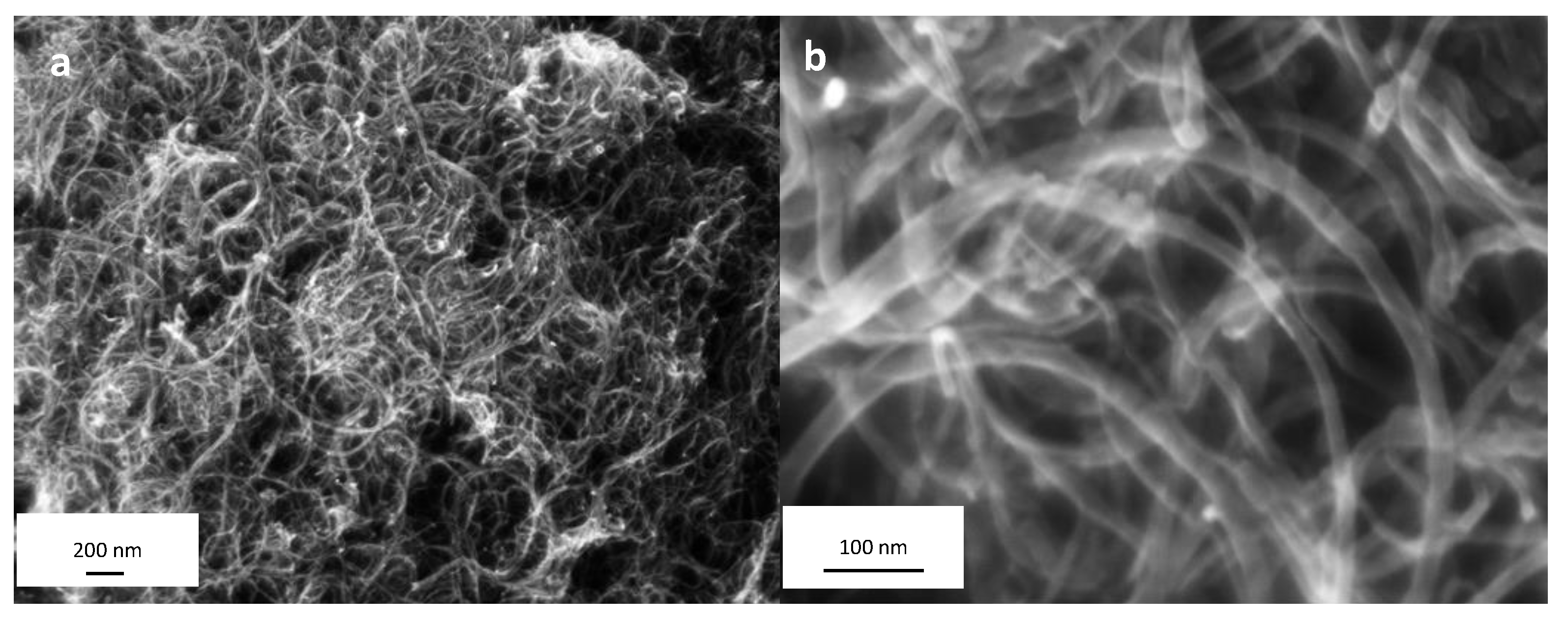

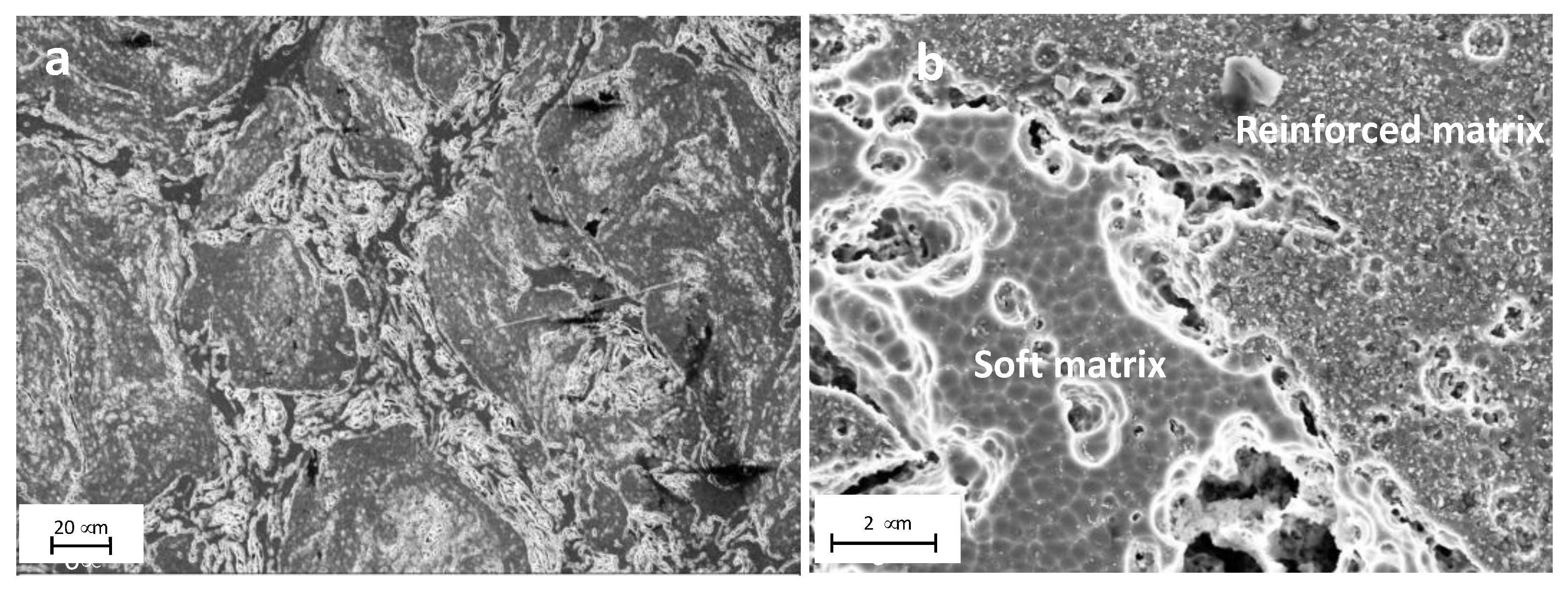


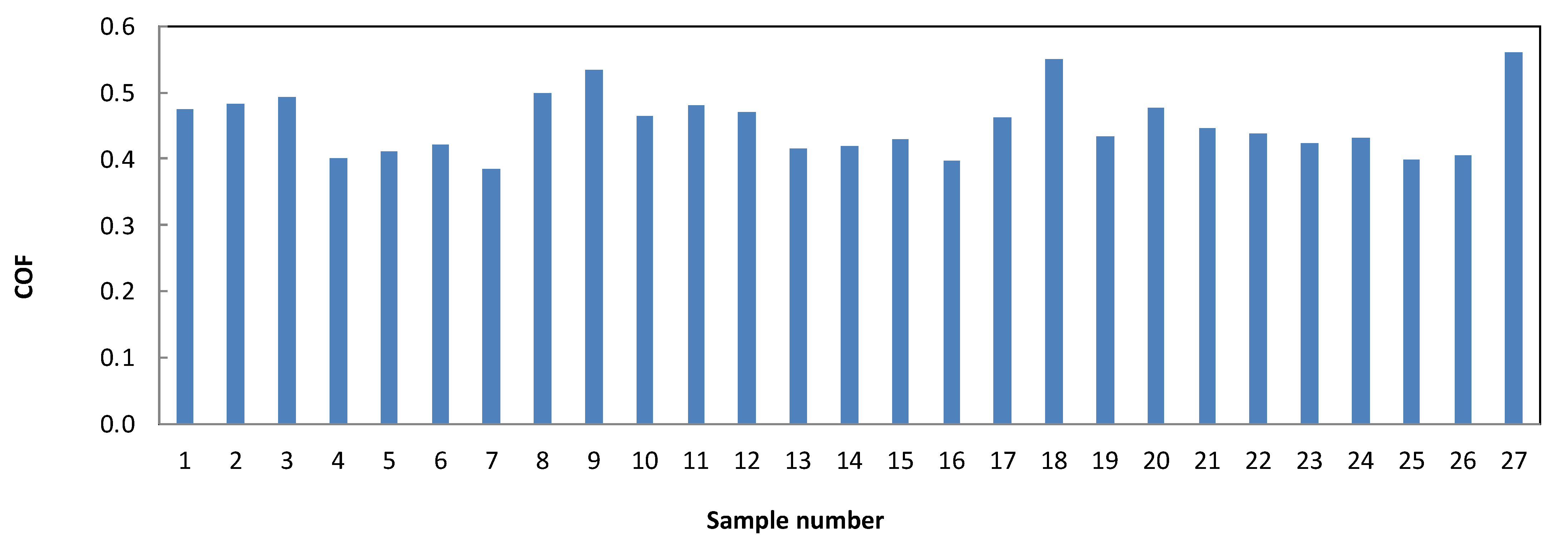

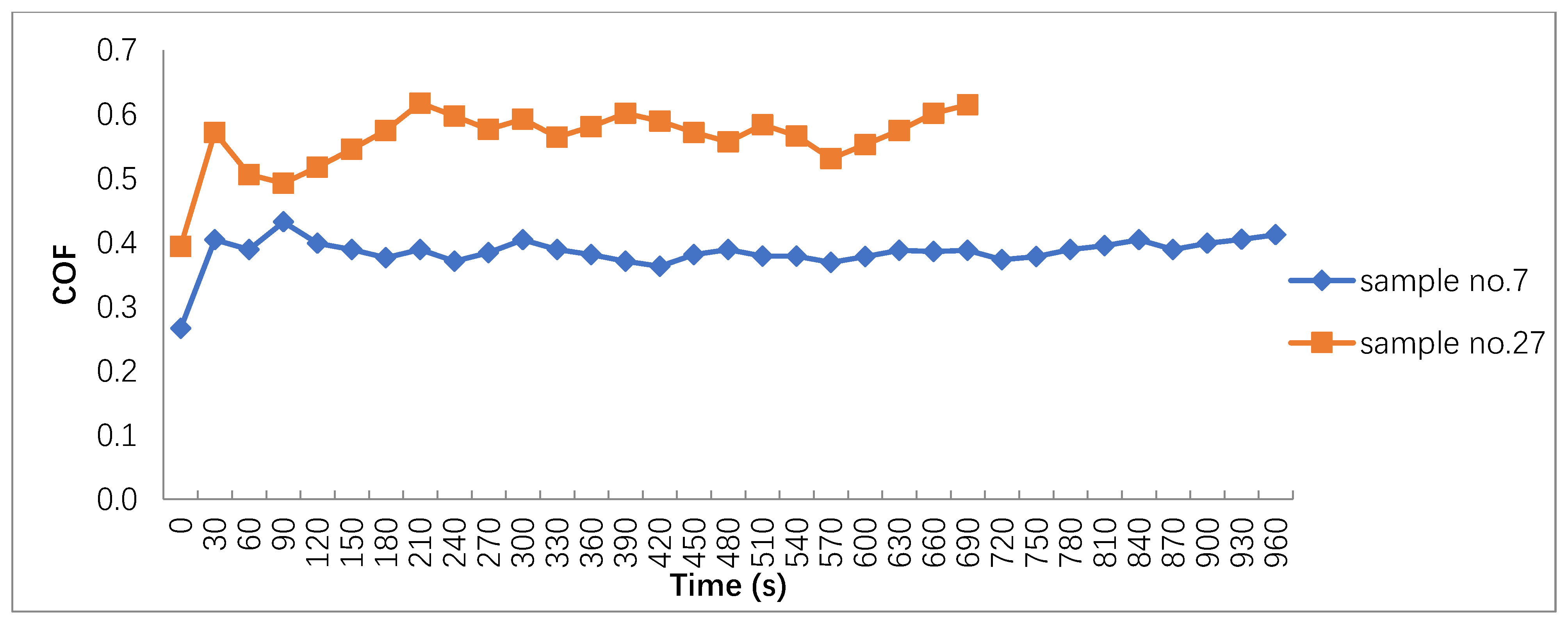
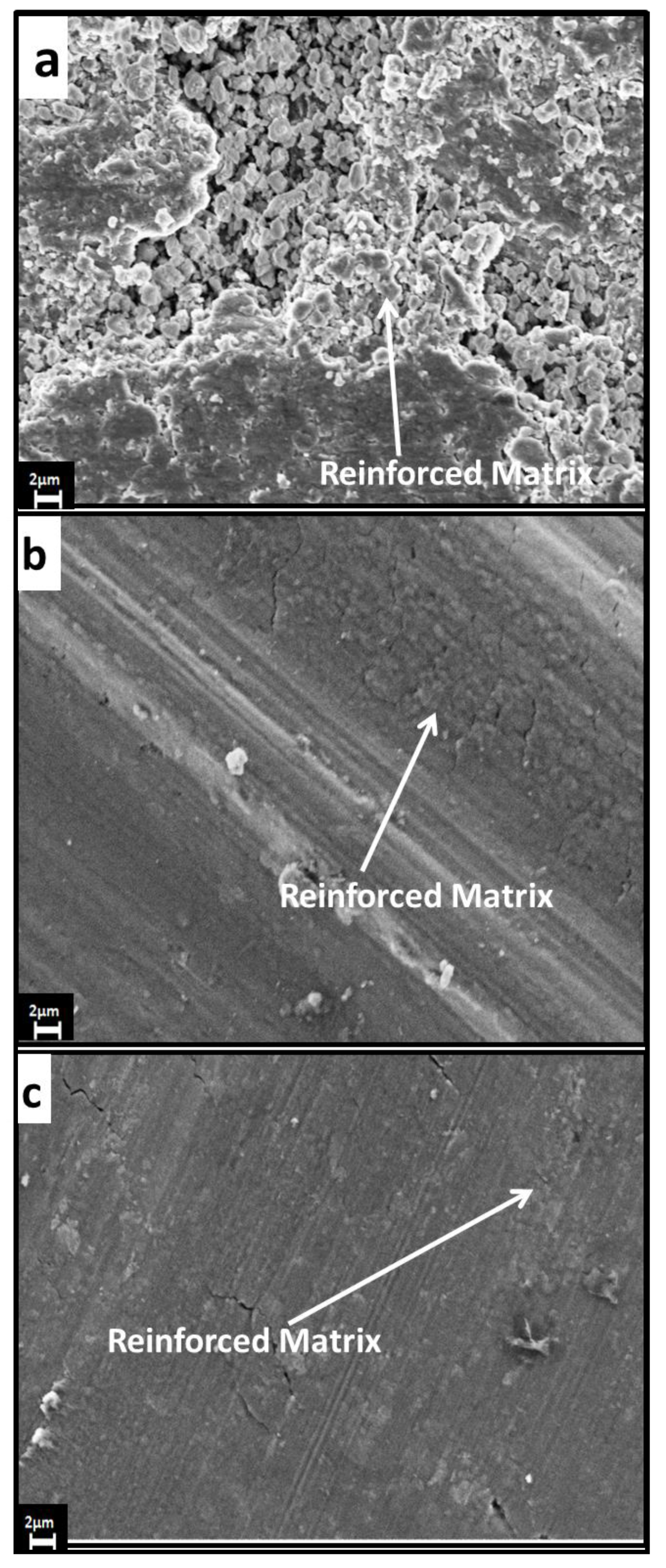
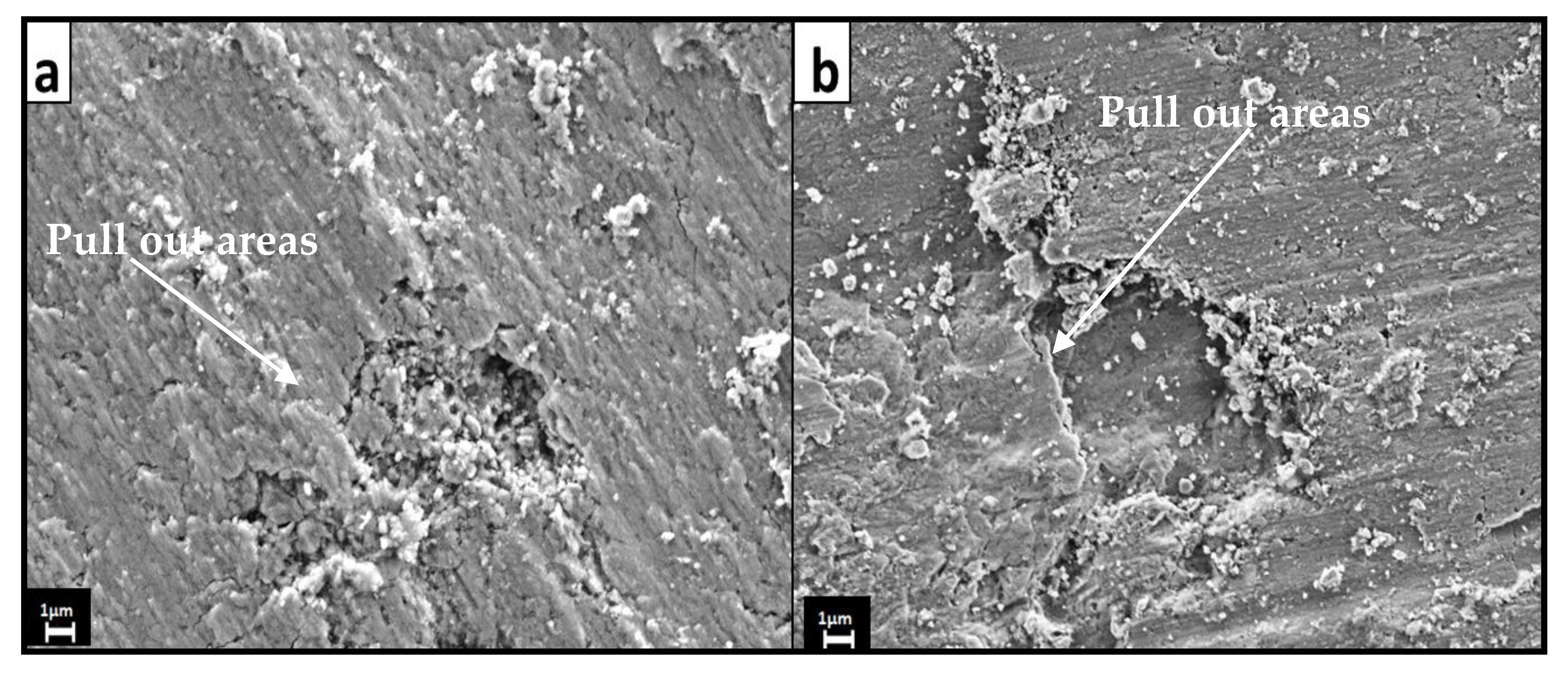
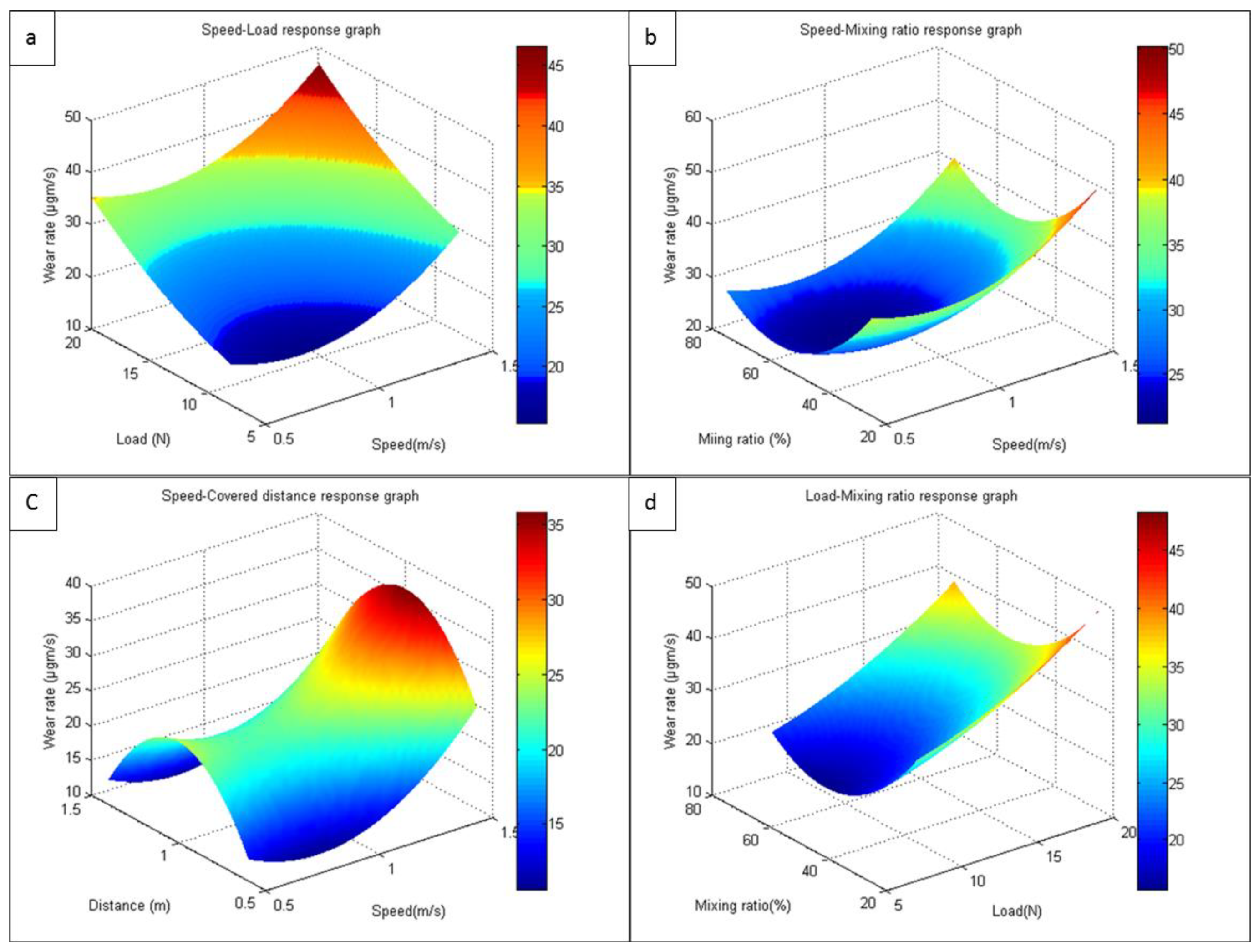
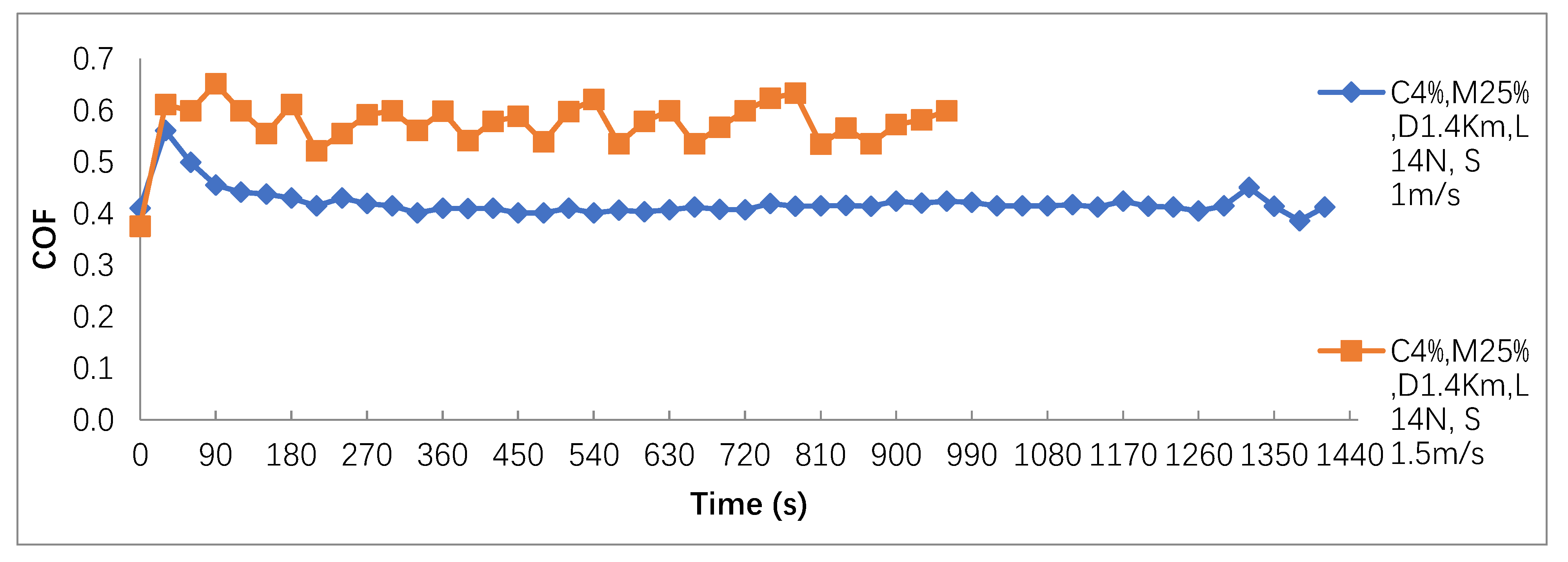

| Control Variables | Symbol | Level 1 | Level 2 | Level 3 |
|---|---|---|---|---|
| wt.% CNT in reinforced matrix | C | 3 | 4 | 5 |
| Linear speed of pin on disk (m/s) | S | 0.5 | 1 | 1.5 |
| Load applied on pin (N) | L | 8 | 14 | 20 |
| Distance covered by pin against disk (Km) | D | 0.6 | 1 | 1.4 |
| Mixing ratio of reinforced to unreinforced particles | M | 25 | 50 | 75 |
| Sample No. | CNT (%) | Speed (m/s) | Load (N) | Distance (Km) | Mixing Ratio (%) |
|---|---|---|---|---|---|
| 1 | 3 | 0.5 | 8 | 0.6 | 25 |
| 2 | 3 | 0.5 | 14 | 1 | 50 |
| 3 | 3 | 0.5 | 20 | 1.4 | 75 |
| 4 | 3 | 1 | 8 | 1 | 75 |
| 5 | 3 | 1 | 14 | 1.4 | 25 |
| 6 | 3 | 1 | 20 | 0.6 | 50 |
| 7 | 3 | 1.5 | 8 | 1.4 | 50 |
| 8 | 3 | 1.5 | 14 | 0.6 | 75 |
| 9 | 3 | 1.5 | 20 | 1 | 25 |
| 10 | 4 | 0.5 | 8 | 0.6 | 25 |
| 11 | 4 | 0.5 | 14 | 1 | 50 |
| 12 | 4 | 0.5 | 20 | 1.4 | 75 |
| 13 | 4 | 1 | 8 | 1 | 75 |
| 14 | 4 | 1 | 14 | 1.4 | 25 |
| 15 | 4 | 1 | 20 | 0.6 | 50 |
| 16 | 4 | 1.5 | 8 | 1.4 | 50 |
| 17 | 4 | 1.5 | 14 | 0.6 | 75 |
| 18 | 4 | 1.5 | 20 | 1 | 25 |
| 19 | 5 | 0.5 | 8 | 0.6 | 25 |
| 20 | 5 | 0.5 | 14 | 1.4 | 50 |
| 21 | 5 | 0.5 | 20 | 1.4 | 75 |
| 22 | 5 | 1 | 8 | 1 | 75 |
| 23 | 5 | 1 | 14 | 1.4 | 25 |
| 24 | 5 | 1 | 20 | 0.6 | 50 |
| 25 | 5 | 1.5 | 8 | 1.4 | 50 |
| 26 | 5 | 1.5 | 14 | 0.6 | 75 |
| 27 | 5 | 1.5 | 20 | 1 | 25 |
Disclaimer/Publisher’s Note: The statements, opinions and data contained in all publications are solely those of the individual author(s) and contributor(s) and not of MDPI and/or the editor(s). MDPI and/or the editor(s) disclaim responsibility for any injury to people or property resulting from any ideas, methods, instructions or products referred to in the content. |
© 2023 by the authors. Licensee MDPI, Basel, Switzerland. This article is an open access article distributed under the terms and conditions of the Creative Commons Attribution (CC BY) license (https://creativecommons.org/licenses/by/4.0/).
Share and Cite
Abdeltawab, N.M.; Esawi, A.M.K.; Wifi, A. Investigation of the Wear Behavior of Dual-Matrix Aluminum–(Aluminum–Carbon Nanotube) Composites. Metals 2023, 13, 1167. https://doi.org/10.3390/met13071167
Abdeltawab NM, Esawi AMK, Wifi A. Investigation of the Wear Behavior of Dual-Matrix Aluminum–(Aluminum–Carbon Nanotube) Composites. Metals. 2023; 13(7):1167. https://doi.org/10.3390/met13071167
Chicago/Turabian StyleAbdeltawab, Noha M., Amal M. K. Esawi, and Abdalla Wifi. 2023. "Investigation of the Wear Behavior of Dual-Matrix Aluminum–(Aluminum–Carbon Nanotube) Composites" Metals 13, no. 7: 1167. https://doi.org/10.3390/met13071167






